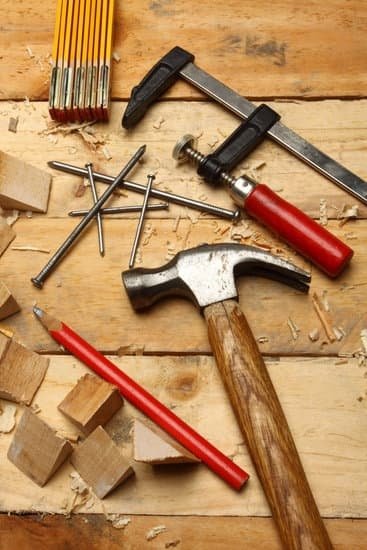Setting up a woodworking shop is not just about having the right tools and equipment; it is about creating a well-organized space that promotes efficiency, safety, and creativity. A well-designed workshop can make all the difference in the quality of your work and your overall enjoyment of the craft.
In this article, we will explore the essential elements to consider when setting up a woodworking shop, including assessing the space, selecting the right tools, organizing workbenches and storage, creating an efficient layout, ensuring proper lighting and ventilation, implementing safety measures, controlling dust and noise, setting up a finishing area, and personalizing your space.
One of the first steps in setting up a successful woodworking shop is assessing the available space. Whether you have a dedicated room or just a corner in your garage or basement, determining the right location and size for your shop is crucial.
The size of your space will dictate how much equipment you can fit and how efficiently you can work. Consider factors such as access to power outlets, natural light sources, and proximity to windows or doors for ventilation purposes.
Once you have determined your space requirements, it’s time to focus on acquiring the essential tools for your woodworking shop. From table saws to hand planes to chisels and routers, having the right equipment is essential for producing high-quality woodwork. We will discuss must-have tools for any woodworking shop and their functions so that you can make informed choices based on your specific needs.
Assessing the Space
Determining the right location and size for your woodworking shop is crucial to ensure a functional and efficient working environment. Careful consideration of these factors will greatly impact your overall productivity, safety, and enjoyment in the workshop. In this section, we will explore some key points to keep in mind when assessing the space for your woodworking shop.
Location
When choosing a location for your woodworking shop, there are several important considerations to take into account. One of the most important factors is noise. Since woodworking can produce loud sounds from machinery and tools, it is essential to locate your shop in an area where noise will not disturb any neighbors or household members. If possible, choose a spot that is not adjacent to living spaces or bedrooms.
Additionally, access to power sources is vital for running machinery and lighting fixtures efficiently. Make sure that the location you choose has easy access to electrical outlets that can handle the power requirements of your equipment. It is also helpful to have good natural lighting if possible, as it provides many benefits such as better visibility and reduced eye strain.
Size
The size of your woodworking shop will depend on several factors, including available space, budget constraints, and anticipated projects. It is essential to have enough space to comfortably move around while working on projects without feeling cramped or restricted.
Consider the size of the largest projects you plan to work on when determining the dimensions of your workshop. Ensure that there is ample space not only for working on projects but also for storage purposes. Leaving room for tool storage cabinets, lumber racks, workbenches, and other necessary equipment will streamline your workflow and prevent clutter.
Remember that a larger space may require more heating or cooling during extreme weather conditions. A well-insulated workshop with proper ventilation will help maintain comfortable temperatures year-round while ensuring safety and preventing damage to your wood supplies and tools.
By carefully assessing the space and considering factors such as location, access to power sources, natural lighting, workshop size, and storage requirements, you can set up a woodworking shop that is tailored to your needs, enabling you to work efficiently and effectively on your projects. The next section will delve into the essential tools every woodworking shop should have and their respective functions.
Essential Tools for a Woodworking Shop
Power Tools
Power tools are essential for any woodworking shop and can greatly enhance productivity and efficiency. Here are some must-have power tools and their functions:
- Table Saw: A table saw is the most important tool in a woodworking shop. It allows you to make precise cuts on larger pieces of wood.
- Miter Saw: A miter saw is perfect for making angled cuts, such as miters or bevels. It is ideal for cutting molding or trimming.
- Router: A router is a versatile tool that can be used for shaping edges, creating dadoes, or making intricate designs.
- Jigsaw: A jigsaw allows you to make curved or irregular shaped cuts in wood. It is perfect for cutting out patterns or creating decorative elements.
- Planer: A planer is used to flatten and smooth wood surfaces, ensuring they are ready for further work.
Hand Tools
While power tools offer speed and precision, hand tools have their own importance in a woodworking shop. They allow for greater control, finer details, and can be used in situations where power tools may not be suitable. Here are some essential hand tools:
- Chisels: Chisels are used for carving, shaping, and smoothing wood surfaces. They come in various sizes and shapes to suit different tasks.
- Hand saws: Hand saws are useful for smaller cuts or when working with delicate materials that may get damaged by power tools.
- Clamps: Clamps serve multiple purposes in a woodworking shop. They hold pieces of wood together during glue-ups or clamping boards together during drying time.
- Measuring Tools: Precision is crucial in woodworking, so having measuring tools like measuring tapes, squares, and calipers is essential to ensure accurate measurements throughout your projects.
Safety Equipment
Safety should always be a top priority when working in a woodworking shop. The following safety equipment is a must-have:
- Safety Glasses: Protect your eyes from flying debris, dust, or accidental splinters.
- Dust Mask: Woodworking produces a lot of dust, which can be harmful to breathe in. A dust mask will help protect your respiratory system.
- Hearing Protection: Operating power tools can be loud and prolonged exposure to high noise levels can damage your hearing. Invest in ear protection like earmuffs or earplugs.
- First Aid Kit: Accidents can happen, so it’s important to have a well-stocked first aid kit on hand for minor injuries.
By equipping your woodworking shop with these essential tools and safety equipment, you’ll be well-prepared to take on any project and ensure the safety of yourself and those around you.
Organizing Workbench and Tool Storage
One of the key aspects of setting up a well-organized woodworking shop is optimizing the space and efficiency of your workbench and tool storage. A cluttered and disorganized workbench can hinder productivity and make it difficult to find the tools and materials you need. By implementing effective organization techniques, you can maximize your workspace, reduce frustration, and improve overall efficiency in your woodworking projects.
To optimize space and efficiency in your workbench area, consider the following strategies:
- Categorize tools: Start by categorizing your tools based on their function or type. This could include separating hand tools from power tools, or organizing tools such as chisels, saws, and measuring equipment into different sections. This will make it easier to locate specific tools when needed.
- Utilize tool organizers: Invest in tool organizers such as pegboards, tool chests, or wall-mounted racks to keep your tools neatly arranged and easily accessible. Pegboards are particularly useful for storing frequently used hand tools, while tool chests with drawers can provide secure storage for smaller items like screws and nails.
- Create dedicated storage areas: Assign specific areas for different types of tools or materials within your workbench. For example, designate one section for measuring equipment, another for drills and drivers, and a separate shelf for wood glue or finishing supplies. Clearly labeling these areas can further aid in finding what you need quickly.
Additionally, it is crucial to maintain cleanliness in your workbench area to ensure optimal efficiency:
- Regularly clean up after each project: Take a few minutes to clean off any debris or sawdust from your workbench after completing a project. This not only keeps your workspace clean but also helps prevent unwanted scratches or damages to future projects.
- Properly store unused materials: Store excess wood or other materials in designated bins or shelving units rather than leaving them scattered on the workbench surface. This frees up valuable workspace and prevents potential accidents or damage to the materials.
By implementing these organization strategies and maintaining a clean workbench area, you can optimize space, enhance efficiency, and create a more enjoyable woodworking experience. With everything in its place and tools readily accessible, you will be able to focus on your projects without unnecessary distractions.
Efficient Layout and Workflow
Creating an efficient layout and workflow is crucial for a well-organized woodworking shop. A logical floor plan ensures that tools, materials, and workstations are easily accessible, maximizing productivity and minimizing wasted time and effort. Here are some key considerations when designing the layout of your woodworking shop.
Analyze Your Workflow
Before finalizing your floor plan, it’s important to analyze your workflow to determine the most efficient arrangement of workstations and equipment. Consider how you typically move around the shop while working on different projects. For example, if you frequently move from the table saw to the router table, ensure that these two stations are located in close proximity to each other.
Group Similar Operations
Grouping similar operations together can streamline your workflow and save time. For instance, consider placing your milling machines, such as jointer and planer, in close proximity to each other so you can easily transition between them without having to travel across the shop. Similarly, grouping hand tools together in dedicated tool storage can enhance efficiency by reducing the time spent searching for specific tools.
Consider Flow of Materials
In addition to considering the flow of your own movements within the shop, it’s essential to think about the flow of materials throughout different stages of a project. To minimize bottlenecks or unnecessary handling of materials, arrange workstations in a way that allows for a smooth progression from raw material preparation to assembly and finishing.
Account for Safety Clearances
When planning your woodworking shop layout, make sure there is sufficient space around each piece of equipment or workstation to ensure safety during operation. Leave enough room for proper ventilation and clearance for long stock or boards when making crosscuts on a miter saw or table saw.
Creating an efficient layout and workflow takes time and careful consideration, but it is well worth the effort. A well-designed woodworking shop will enhance your productivity, improve the quality of your work, and make your woodworking experience more enjoyable overall.
Lighting and Ventilation
One of the most important aspects of setting up a woodworking shop is ensuring proper lighting and ventilation. These factors are crucial for both the safety and comfort of the woodworker. Inadequate lighting can make it difficult to see the details of your work, increasing the risk of accidents. Poor ventilation can lead to health hazards from dust and fumes, making it necessary to take proper precautions.
When it comes to lighting, natural light is ideal, but not always possible in every workshop. In such cases, a combination of overhead lighting and task lighting can be used to create an evenly lit workspace. Overhead lighting should be bright and evenly spread throughout the entire area. Task lighting, on the other hand, provides focused illumination for specific work areas, such as the workbench or various tools.
Besides lighting, proper ventilation is equally important in a woodworking shop. Wood dust and fumes from paints or solvents can pose health risks if inhaled continually without proper ventilation. Installing an effective ventilation system that includes exhaust fans or windows is essential for maintaining good air quality in your workspace.
Ensuring safety and comfort in a woodworking shop also involves considering other environmental factors such as temperature control. Extreme temperatures can affect both the wood being worked on as well as the comfort level of the woodworker. Therefore, it’s important to have proper insulation and ensure appropriate heating or cooling options are available in your workshop.
| Lighting Tips | Ventilation Tips |
|---|---|
| – Use a combination of overhead lighting and task lighting | – Install an effective ventilation system with exhaust fans or windows |
| – Ensure even distribution of bright overhead lights throughout the workshop | – Regularly clean dust collection systems to prevent clogging |
| – Use task lighting for focused illumination in specific work areas | – Take breaks and step outside the shop to breathe fresh air periodically |
Safety Measures and Equipment
Woodworking can be a fulfilling and enjoyable hobby or profession, but it also comes with inherent risks. Safety should always be a top priority when setting up a woodworking shop. By implementing the right safety measures and having the necessary equipment in place, you can create a safe environment for yourself and anyone else who may enter your shop.
Here are some essential precautions to consider for creating a safe woodworking environment:
- Personal Protective Equipment (PPE): One of the most important safety measures is wearing appropriate PPE. This includes safety glasses or goggles to protect your eyes from flying debris, ear protection to prevent hearing damage from loud machinery, dust masks or respirators to minimize inhalation of fine particles, and sturdy footwear to protect your feet from falling objects or sharp tools.
- First Aid Kit: Accidents happen, even in well-organized shops. It is crucial to have a fully stocked first aid kit readily available in case of any injuries. The kit should include items such as bandages, antiseptic solution or wipes, adhesive tape, sterile gloves, tweezers, and scissors.
- Fire Safety: Woodworking involves working with flammable materials such as solvents and finishes. To prevent fires, ensure that your shop is equipped with appropriate fire extinguishers and smoke detectors that are regularly maintained and easily accessible. Additionally, keep a clear path out of the shop in case of an emergency.
- Machine Guarding: Machinery in a woodworking shop can be hazardous if not used properly or if it lacks proper guarding mechanisms. Make sure all power tools have guards in place that effectively cover blades or cutting edges when not being used. Regularly inspect these guards for any damages or malfunctions.
- Cleanliness and Organization: A cluttered workspace increases the risk of accidents and injuries due to tripping hazards or difficulty maneuvering around tools and equipment. Keep your shop clean by regularly sweeping up sawdust, shavings, and debris. Properly store tools and equipment to avoid any accidental falls or injuries. Implement a system to quickly identify and dispose of any waste materials, such as sawdust or wood scraps, which can contribute to fire hazards.
By implementing these safety measures and having the necessary equipment in place, you can create a safe woodworking environment that allows you to focus on your craft without compromising your well-being. Remember, safety should never be overlooked when setting up and operating a woodworking shop.
Dust Collection and Noise Control
Woodworking involves the use of power tools that can generate significant amounts of dust. Breathing in this dust can pose serious health risks, including respiratory issues and allergies. To create a safe and healthy woodworking environment, it is essential to have a proper dust collection system in place. Here are some key considerations for minimizing health hazards associated with dust:
- Install a dust collection system: A dedicated dust collection system is necessary to effectively capture and remove dust particles from the air. This system consists of an industrial vacuum or central collector connected to individual machines through ductwork. It is important to choose a properly sized collector that can handle the volume of dust generated by your woodworking tools.
- Use efficient air filtration: In addition to a dust collection system, it is recommended to install an air filtration unit in your workshop. This helps remove any remaining fine particles that may have escaped capture by the collector. Look for high-efficiency particulate air (HEPA) filters, which are capable of trapping even the smallest particles.
- Wear personal protective equipment (PPE): PPE such as respirators or dust masks should be worn when working with wood materials or operating power tools that generate a lot of airborne particles. Make sure to select PPE with appropriate ratings for filtering out small debris.
Noise can also be a disruptive factor in a woodworking shop, not only affecting your own comfort but also potentially causing disturbances for neighbors or family members living nearby. To address noise control in your workshop:
- Soundproofing measures: Consider soundproofing the walls and ceiling of your workshop using materials like acoustic panels or insulation foam. These materials absorb sound waves and help reduce noise transmission.
- Isolating noisy equipment: Place loud machines or tools away from quieter areas, ensuring they are not directly touching any surfaces that could amplify vibrations or noise transmission.
- Hearing protection: Protect your ears by using earmuffs or earplugs while operating loud machinery. It is important to wear hearing protection that is specifically designed for noise reduction and provides adequate noise reduction ratings (NRR).
By implementing these dust collection and noise control measures, you can create a safer and more enjoyable woodworking environment. Taking proactive steps to minimize health hazards and disturbance will help ensure a successful and productive experience in your woodworking shop.
Setting Up a Finishing Area
When it comes to woodworking, the finishing process is what truly brings out the beauty of your projects. A well-designed and organized finishing area is crucial to achieve perfectly finished pieces. In this section, we will discuss the proper techniques and equipment needed to set up a finishing area that will ensure success in your woodworking endeavors.
One of the key considerations when setting up a finishing area is ventilation. Proper ventilation is essential to ensure the safety of both the woodworker and the environment. When working with finishes such as varnishes, lacquers, or paints, harmful fumes can be released into the air.
These fumes can not only be hazardous to your health but can also affect the quality of your finishes if they are allowed to settle on your projects. Therefore, it is important to have good airflow in your finishing area. This can be achieved through the use of fans, open windows, or exhaust systems.
In addition to proper ventilation, lighting plays an important role in achieving high-quality finishes. The right lighting allows you to see imperfections and make adjustments where needed. Natural daylight provides the most accurate representation of colors and textures; however, if this is not possible in your workspace, consider investing in high-quality artificial lighting that closely mimics natural light. Additionally, using full-spectrum bulbs minimizes shadows and provides even lighting throughout your finishing area.
Equipment-wise, there are a few essentials for a well-equipped finishing area. Firstly, you will need adequate work surfaces for applying finishes. This can include sturdy tables or benches with smooth surfaces that are easy to clean.
It’s also important to have an assortment of brushes and applicators suitable for different types of finishes. Additionally, having separate storage areas specifically designated for storing finishing materials such as brushes, rags, solvents, and sanding pads ensures that everything is easily accessible when you need it.
By setting up a finishing area with proper ventilation, lighting, and essential equipment, you can achieve the perfect finishes that will truly showcase the beauty of your woodworking projects. With careful attention to detail in this important stage of the woodworking process, you can elevate your craftsmanship and create pieces that are not only functional but visually stunning as well.
| Equipment | Purpose |
|---|---|
| Ventilation System | Ensures proper airflow and removes harmful fumes from the finishing area |
| Work Surfaces | Provides a smooth and clean space for applying finishes |
| Brushes and Applicators | Makes applying finishes precise and even on different surfaces |
| Storage Areas | Dedicated spaces for keeping finishing materials organized and easily accessible |
Personalizing Your Woodworking Shop
Personalizing your woodworking shop is an important step towards creating a space that is not only functional but also reflects your personality and style. By adding comfort, inspiration, and aesthetic touches, you can transform your shop into a place where you enjoy spending time and feel motivated to work on your projects.
One way to personalize your woodworking shop is by adding comfortable seating options. Whether it’s a stool, chair, or even a cozy corner with a cushioned bench, having a comfortable place to sit can make a big difference in your overall experience in the shop. It allows you to take breaks when needed and provides a space for reflection or planning. Additionally, having seating options for visitors or fellow woodworkers can create a welcoming atmosphere in your shop.
Another way to personalize your woodworking shop is by incorporating elements of inspiration. Consider displaying finished projects or works-in-progress that inspire you or represent milestones in your woodworking journey. This could be done through wall-mounted shelves for small pieces or custom-made display cases for larger projects.
You can also hang up photographs of inspiring places or people related to woodworking. These visual reminders can serve as motivation during those times when you may feel stuck or uninspired.
Lastly, don’t forget about the aesthetics of your woodworking shop. Adding decorative touches can enhance the overall ambiance and make the space more visually appealing. This could involve painting the walls in a color that energizes you or using wallpaper that reflects your personal style. Incorporating artwork such as framed prints or posters related to woodworking can also contribute to the overall aesthetic appeal of the shop.
| Personalization Aspect | Description |
|---|---|
| Comfortable Seating Options | Add stools, chairs, or cushioned benches for breaks and visitor seating. |
| Inspiration Display | Showcase finished projects or works-in-progress that inspire you. Hang up photographs related to woodworking. |
| Aesthetic Touches | Introduce pleasing colors through paint or wallpaper choices. Display artwork or posters related to woodworking. |
Conclusion
In conclusion, setting up a well-designed and organized woodworking shop is essential for ensuring success in your woodworking endeavors. By carefully assessing the space available and determining the right location and size for your shop, you can create an environment that is conducive to efficient work and optimal productivity.
Equipping your woodworking shop with essential tools and organizing them effectively not only saves time but also enhances safety. A well-designed workbench and tool storage system will maximize space utilization and ensure that everything is easily accessible when needed. Additionally, investing in proper lighting and ventilation systems will contribute to a comfortable and safe working environment.
Implementing safety measures and equipment should be a top priority when setting up a woodworking shop. This includes wearing protective gear, installing fire extinguishers, and having first aid kits readily available. Moreover, minimizing health hazards through dust collection systems and noise control methods is crucial for maintaining a safe and healthy working space.
Lastly, adding personal touches to your woodworking shop can enhance inspiration, comfort, and aesthetic appeal. Consider incorporating elements such as artwork or motivational quotes on the walls, as well as comfortable seating areas for relaxation or brainstorming sessions.
Overall, by following these guidelines for setting up a well-designed and organized woodworking shop, you are bound to have a successful woodworking experience. Remember that careful planning, efficient layout design, proper tool storage, safety precautions, attention to detail like lighting/ventilation systems/dust control measures etc., all contribute towards creating an environment where creativity can flourish while ensuring user safety. With the right setup in place, you’ll be equipped to tackle any woodworking project with confidence.

Hi everyone! I’m a woodworker and blogger, and this is my woodworking blog. In my blog, I share tips and tricks for woodworkers of all skill levels, as well as project ideas that you can try yourself.





